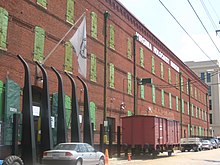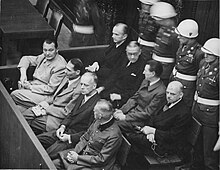Virginia Holocaust Museum

The Virginia Holocaust Museum is a museum founded in 1997 by Jay M. Ipson to commemorate the Holocaust and is located in Richmond, Virginia .
General
With guided tours of the museum, reading, films and events, the museum aims to educate the public to be more tolerant . The museum's official motto is “Tolerance Through Education”. There are currently 28 exhibitions in the museum. Several hundred school classes visit the museum every year.
history
In the 1980s, Ipson began speaking in schools about his experiences during the Holocaust. He regularly left the house at 6 a.m. to give a lecture punctually for the start of school and then drove to work until friends suggested that it would be easier to let the school classes arrive.
In 1997 Ipson organized a corresponding exhibition with Mark E. Fetter and Al Rosenbaum next to the local synagogue Temple Beth El . With that, the Virginia Holocaust Museum was born. Since the premises became too small due to the great interest, they looked for a larger building. With the support of Congressman Eric Cantor , a former tobacco factory was made available to Ipson in 2001 as the new location for the museum. The museum was only able to reopen in 2003 with great financial and time expenditure. In the first year the museum had more than 10,000 visitors from all states of the USA , but also from Europe , Asia and South Africa .

Since then, the Virginia Holocaust Museum has expanded continuously and has seen more than 175,000 visitors since its inception. In 2007 it celebrated its 10th anniversary. For this reason, numerous events took place. Since 2008 the museum has been home to the world's only, faithfully reconstructed courtroom of the Nuremberg trials . This room was opened with the name “Palace of Justice”.
An Austrian memorial service can be performed in the Virginia Holocaust Museum .
Exhibitions
When you enter the museum, you are transported back to the time of National Socialism . You experience the atmosphere of the Dachau concentration camp and later find yourself in the dining room of a Jewish family, where you can hear radio news about the November pogroms of 1938.
Later one arrives at a ghetto in Lithuania , from which one “escapes” and crawls into the shelter of the Ipson family. This leads to the fate of the Ipson family, who had to flee from the Kaunas ghetto in Lithuania and found shelter for six months in a hole in the ground near a farm. Jay M. Ipson, who came to the “Kovno Ghetto” with his family at the age of six, is now the director of the museum. A freight car takes you to the “ final solution ” and to the gas chamber , through which you get to the crematorium .
Then you come to a room that shows the liberation by the Allies and then to a DP camp . The immigration ship " Exodus " takes you to Palestine .
In addition to the Survivor's Room (exhibition to commemorate Holocaust survivors), the freight car in front of the museum is also a place for silent remembrance. This wagon was made available to the museum by Alexander Lebenstein's friend Erwin Kirschenbaum as part of a project of the German Alexander-Lebenstein-Realschule from Haltern am See .
Choir synagogue
The synagogue integrated into the museum was built on the model of the famous Choir Synagogue ( Lithuania ). In 2009, after several years of efforts, Jay M. Ipson was able to get the Virginia Holocaust Museum to receive a Torah that had been kept in hiding during the Holocaust in Lithuania and that was brought to Israel after its discovery. It has been in the museum's synagogue since its extensive restoration.
Civil substitute service at the VHM
The Austrian Foreign Service Association is a sponsoring organization recognized by the Federal Ministry of the Interior in accordance with Section 12b ZDG, which offers Austrians who are obliged to do civil service the opportunity to do a 12-month civil substitute service abroad. This can be done in the form of a memorial service (Austrian Holocaust Memorial Service) in cooperation with the VHM.
Web links
- Official website (English)
- Austrian Memorial Service at the Virginia Holocaust Museum
- Opening of the “Palace of Justice”
Individual evidence
Coordinates: 37 ° 31 '51.1 " N , 77 ° 25' 34.1" W.